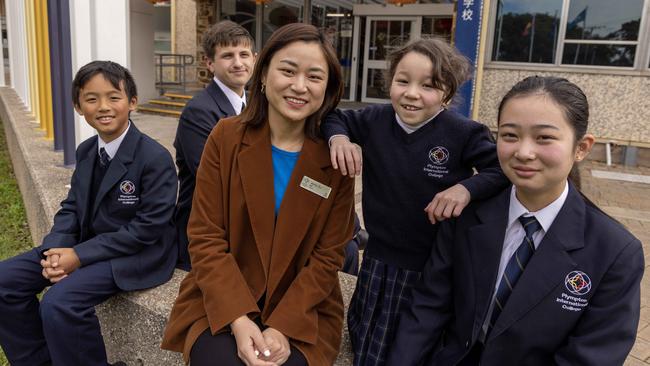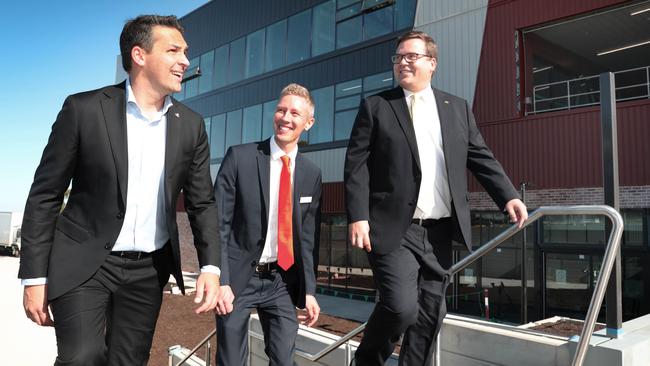Underperforming South Australian state schools target of new standards push to help relieve pressure on bursting campuses
SA’s most underperforming public schools are the target of a push to lift student standards, relieve bursting campuses and avoid new school zones. Search the data.

SA News
Don't miss out on the headlines from SA News. Followed categories will be added to My News.
The state’s most under performing public schools are the target of an official campaign to lift student standards to relieve other bursting campuses and avoid new enrolment zones.
Latest Education Department data, released under Freedom of Information laws, shows almost 70,000 free students spots across the state despite more schools facing a capacity crisis.
The figures, based on detailed population growth forecasts, shows 27 of the state’s most popular schools will be over capacity next year, before that total rises to 31 in 2025.
The state government will today unveil a new “make every school a great school” program that will focus on the most disadvantaged areas, targeted infrastructure spending, encouraging parents to choose local schools and offering more specialist teaching streams.
Education Minister Blair Boyer, who has no plans to change existing zones, said a top priority will be to “actively target and lift the reputation and quality of key schools”.
Mr Boyer, a father of three schoolchildren, said he understood people might be “cynical” about the new government push but efforts in some schools were already producing results.

“If we look to recent history about what has been done by successive governments, Labor and Liberal, is they’ve taken what’s actually financially the easier route and just expand the schools that are already super popular,” he said.
“Because that solution is less complicated than going and looking at a school … and saying, ‘what do we do to turn this around’.
“Now I think this government is showing a willingness to try something different at those schools that have languished for a long time.”
Plympton International College, which Mr Boyer highlights as a poster school in Adelaide’s inner southwest for turning its fortunes around, has the biggest shortage of places next year at almost 200, the data shows.
The school, with a pioneering Chinese Mandarin bilingual language program, has almost tripled its enrolments from 375 in 2017 – when it faced closure – to 1108 next year.
The north east’s The Heights School, for preschool to Year 12 at Modbury Heights has the next biggest 2024 shortfall with 191, followed by 114 at Edwardstown Primary, in the inner south, and Glenunga International in the east.
Another 25 schools will have fewer than 20 places available in 2024, including zero available places at Morialta Secondary College, in the east.
This total grows to 23 schools in 2025.
In contrast, the new Aldinga Payinthi and Riverbank colleges along with Renmark primary and Adelaide Botanic high have the most places available.
Mr Boyer said ta 20 year infrastructure plan will be published once the Gillard Royal Commission into preschool plans reports later this year.
The Education Department is finalising two business cases for new schools at Mt Barker and in Adelaide’s outer north, likely past Elizabeth to cater for the state’s fastest growing areas.
Mr Boyer believes preschool to Year 12 schools with caps of around 1500 students is a workable model.
Virginia Primary has the biggest need for an upgrade while Findon High is undergoing a $45m overhaul for a technical college.
Underdale High, which just had a $20m upgrade in the west, and Valley View Secondary, at Para Vista in the north east – undergoing a $14m overhaul – are also government targets to boost enrolments.
“Ministers for education are fond of saying it’s the quality of the teaching and the staff inside the classrooms that really counts, not what’s on the outside,” Mr Boyer said.
“Parents always have, and always will, make at least part of their assessment … by looking at the infrastructure and buildings of that school. It’s just the reality of the situation.
“They spend more time cutting across the city or going somewhere else when they should be able to rely on the local school they find they’re very happy to send their kids to.”

Opposition spokesman John Gardner, a former Liberal government Education Minister, welcomed the efforts.
He said his government had created new entrepreneurial specialist streams at five schools and the International Baccalaureate diploma at four other sites.
“The department has to be looking at, and investing in, all schools that have capacity challenges to ensure we are not overly cramming students in schools,” he said.
“If the government can support more specialisms …. I think those schools that have not had the reputation they may have wanted, have some expertise that will encourage families to have confidence in their children going there.
“It is very good to pursue excellence in every school.
“But alongside that you do need to have investment in capacity as well as particularly with demographic changes within suburbs in the city.”
Plympton International principal, Roy Webb, 69, said the school was developing a rich culture, combined with languages and an excellent location.
“All schools are amazing,” he said. “There is no such thing as a bad school.”
Chinese teacher Jenny Xu, 34, who came to Adelaide as an international student in 2012, said its language program gave students an edge in a global jobs market.
More Coverage
Originally published as Underperforming South Australian state schools target of new standards push to help relieve pressure on bursting campuses




